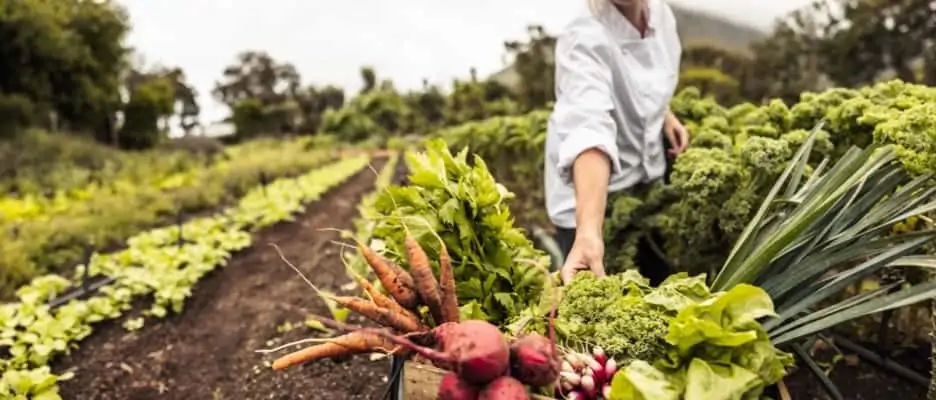Have you heard of the Sustainable Diet? Choosing healthier foods that have a lower environmental footprint (Part Two)

According to the UN Food and Agriculture Organization (FAO), a sustainable diet is:
- healthy
- has a low environmental impact
- is affordable
- is culturally acceptable.[10]
This is great to know, but you may be wondering how to choose the most environmentally friendly foods.
What dietary choices are the most sustainable and the healthiest?
The science is pretty clear: Foods that have a lower impact on our environment – and a better impact on our health – are plants. Increasing your intake of fruits, vegetables, grains, nuts, and seeds can improve you and the earth. There is a huge body of research showing that the more plants you eat, the lower your risks of diabetes, heart disease, stroke, and obesity.[15,16] Decreasing your intake of red and processed meats can also lower those health risks while also reducing your impact on the environment.[10]
This doesn’t mean that you must stop eating all meat today. Meat is an integral part of many diets and a go-to source of vitamin B12, iron, and protein. But by simply replacing some of your red or processed meats with plants, you can start making a difference today.
And the winners are…
There isn’t one single eating style that is the clear winner when it comes to sustainability. In fact, there are several that can positively influence the environment. A recent review of 63 studies in PLoS One rated different diets according to whether they helped reduce greenhouse gases, water use, and land use[10]. The top three diets that help reduce greenhouse gas emissions are vegan, vegetarian, and the healthy guidelines (with further environmental optimization). The top three diets that reduce water use are vegetarian, Mediterranean, and pescatarian. And the top three diets to reduce land use are vegan, vegetarian, and pescatarian.
What do each of those diets consist of?
Vegan = Only plant-based foods (no meat, poultry, fish, dairy, or eggs)
Vegetarian = Plants, dairy, and eggs (no meat, poultry, or fish)
Healthy Guidelines (and further optimization) = National dietary guidelines from many countries (Europe, the USA, Australia) that were optimized to generate additional environmental benefits
Mediterranean = Plants, poultry, fish, and eggs (limited red meat and dairy)
Pescaterian = Plants, fish, dairy, and eggs (no meat or poultry)
[Interestingly, the 2019 revised version of Canada’s Food Guide (created without industry lobby) no longer specifically recommends meat and dairy as two essential food groups. It has instead put them together into a new group called “protein.” So, the new recommendations include one-half of your plate being fruits and vegetables, one-quarter is whole grains, and the last quarter is protein—plant- or animal-based. Oh, and the drink of choice is water.][17]
You don’t have to overhaul everything you eat, or choose a specific eating style. By simply making a few adjustments, you can make progress towards eating more sustainably. The next time you plan meals or go grocery shopping, think about how much food you really need to avoid waste, reduce your meat (particularly beef) intake by a few meals each week[11], and watch as you save money (stay tuned for Part 3 for my best tips/strategies for this!).[18]
Environmental impact of different types of foods
The number one factor that drives the environmental impact of food is how it’s produced.[10] Food production is responsible for between 25-30% of the world’s greenhouse gas emissions.[10,11] How crops are grown and how livestock is raised makes a bigger impact on the environment than how much it’s processed or how far it’s been transported.[10,11]
In general, plant-based food produces fewer greenhouse gases and uses less land and water to grow than animal-based food.[10,18] At least half of the greenhouse gases from agriculture come from one single area: livestock.[9,11] According to the International Panel on Climate Change, “Livestock are responsible for more greenhouse gas emissions than all other food sources.”[19] Of all the livestock, cows are particularly impactful as cattle are responsible for about two-thirds of greenhouse gases.[19] Why blame it on the cows? Because methane is released from the natural fermentation process that occurs in their (rumen) digestive systems.[19] In addition to the release of greenhouse gases from cow burps and cow dung, beef has a large impact on how much freshwater and land we use.[9,11]
Another way to look at sustainability is to calculate how much fossil fuel is needed to produce one calorie of protein from beef versus a plant-based food like soy. It takes about 54 calories worth of fossil fuel to produce 1 calorie worth of beef protein, while it takes just 2 calories of fossil fuel to produce 1 calorie worth of protein from soy[20].
The most impactful sustainable food choices
If you learn only one thing from this article, I hope it is this: The number one thing you can do from a dietary perspective to reduce your environmental impact is to reduce how much meat you eat—particularly ruminant meat like beef.[10,11,19] Plant-based foods that are healthier include vegetables, such as carrots and tomatoes, not plant-based brownies and potato chips.:)
One fun way to achieve personal health and planetary survival is to start enjoying Meatless Mondays. Curious what to cook? Look for a few meatless recipes at the end of this post.
Sustainable food swaps
One of the main reasons people consume meat is because it’s a great source of protein. And people often worry about where they’ll get their protein if they reduce their meat intake. But did you know that there are a bunch of nutritious plant-based sources of protein that you can enjoy instead? Try:
- Tofu
- Chickpeas
- Soy
- Beans
- Lentils
- Edamame
- Peas
- Nuts
- Seeds
- Whole grains.
Simple choices
Sometimes simple choices are the best way to make a difference for your health and the earth. Replacing even a few meat-based meals each week (particularly beef) can help you boost your health and reduce your environmental footprint[11].
Here is another delicious meatless entree that will provide plenty of protein for your Meatless Mondays, or Tuesdays, or Wednesdays…

Did you see Part 1 of this series? Find out why Mother Earth is depending on you.
Check out Part 3 and get tips on reducing food waste and saving money!
If you have any questions, please feel free to contact me at info@nancyleehall.com
References
9 – Grinspoon, P. (2019, March 26). Cleaner living: Plant-friendly is planet-friendly. Harvard Health. https://www.health.harvard.edu/blog/cleaner-living-plant-friendly-is-planet-friendly-2019032516269
10 – Aleksandrowicz, L., Green, R., Joy, E. J., Smith, P., & Haines, A. (2016). The Impacts of Dietary Change on Greenhouse Gas Emissions, Land Use, Water Use, and Health: A Systematic Review. PloS one, 11(11), e0165797. https://doi.org/10.1371/journal.pone.0165797
https://www.ncbi.nlm.nih.gov/pmc/articles/PMC5094759/
11 – Ritchie, H. (2020, January 24). You want to reduce the carbon footprint of your food? Focus on what you eat, not whether your food is local. Our World in Data. https://ourworldindata.org/food-choice-vs-eating-local
12 – Svoboda, E. (2021, April 28). Can gratitude help you live more sustainably? Greater Good Magazine.
https://greatergood.berkeley.edu/article/item/can_gratitude_help_you_live_more_sustainably
13 – Kates, S., & DeSteno, D. (2020). Gratitude reduces consumption of depleting resources. Emotion (Washington, D.C.), 10.1037/emo0000936. Advance online publication. https://doi.org/10.1037/emo0000936
https://pubmed.ncbi.nlm.nih.gov/33370142/
14 – Lowrey, A. (2021, April 6). Your Diet Is Cooking the Planet: But two simple changes can help. The Atlantic. https://www.theatlantic.com/health/archive/2021/04/rules-eating-fight-climate-change/618515/
15 – Tello, M. (2018, November 29). Eat more plants, fewer animals. Harvard Heath. https://www.health.harvard.edu/blog/eat-more-plants-fewer-animals-2018112915198
16 – Micha, R., Peñalvo, J. L., Cudhea, F., Imamura, F., Rehm, C. D., & Mozaffarian, D. (2017). Association Between Dietary Factors and Mortality From Heart Disease, Stroke, and Type 2 Diabetes in the United States. Journal of the American Medical Association, 317(9), 912–924. https://doi.org/10.1001/jama.2017.0947
https://www.ncbi.nlm.nih.gov/pmc/articles/PMC5852674/
17 – Health Canada. (2021, April 9). Canada’s Food Guide. https://food-guide.canada.ca/en/
18 – Health Canada. (2020, October 14). Healthy Eating and the Environment.
https://food-guide.canada.ca/en/tips-for-healthy-eating/healthy-eating-and-the-environment/
19 – International Panel on Climate Change.(2018). Special Report: Global warming of 1.5 ºC. https://www.ipcc.ch/sr15/chapter/chapter-4/
20 – Schwarcz, J. (2017, March 20). The Environmental Cost of Meat. McGill Office for Science and Society. https://www.mcgill.ca/oss/article/science-science-everywhere/environmental-cost-meat

